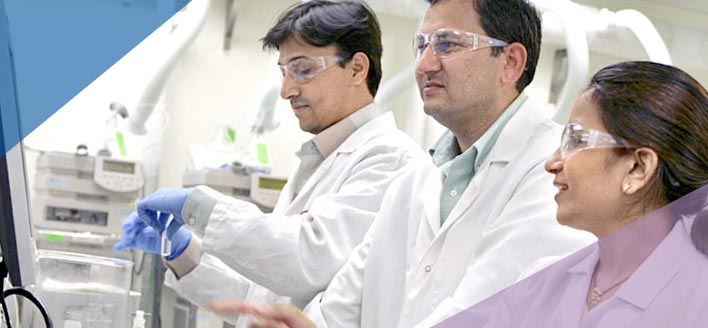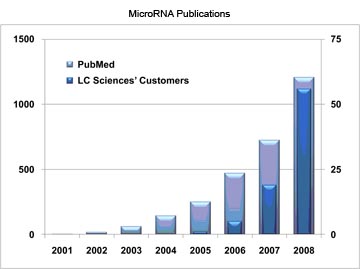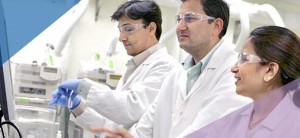LC Sciences has announced the availability of a custom target enrichment service for next-generation sequencing applications. LC Sciences now provides a service for Target-Specific Selection of a defined genomic region (such as Mbp region at a specific location, suspected cancer regions, SNP regions,  regions for genomic comparisons) or RNA sequences (such as sets of transcriptome sequences known f r o m previous screening experiments, mRNAs, and miRNAs). This new service enables researchers to take full advantage of new “next-generation†high throughput sequencing technologies.
regions for genomic comparisons) or RNA sequences (such as sets of transcriptome sequences known f r o m previous screening experiments, mRNAs, and miRNAs). This new service enables researchers to take full advantage of new “next-generation†high throughput sequencing technologies.
It is clear that these new sequencing technologies can be more effectively utilized for systematic studies of genetic variation by targeting certain specific regions (subsets) of complex genomes. Essentially, our service achieves more coverage and deeper sequencing by reducing sample complexity and focusing reads on the areas of interest.
LC Sciences µParaflo® technology’s unique combination of advanced microfluidics and innovative synthesis chemistry provides a robust synthesis process which is necessary to achieve high quality selection and the flexibility to handle almost any target selection project. This technology has been used to produce custom sequence microarrays [Nucleic Acids Res. 2004,32,5409] and custom designed oligonucleotide mixture libraries (OligoMix®) [Nature. 2004,432,1050] since 2003 and is now particularly well suited to providing target selection solutions. The versatility of the technology makes it a good fit for the diverse needs of researchers embarking on new high-throughput sequencing projects.
“It’s really the flexibility of the technology that sets it apart f r o m othersâ€, says Dr. Christoph Eicken, Head of Technical Services, Microarrays. “First, this is a completely custom synthesis technology, meaning almost any selected genomic region of any species and all known RNA transcripts can be targeted. Second, target selection may be achieved by hybridization using complementary capture probes immobilized on surface or by in-solution hybridization. By altering the target selection approach we take, we can address the widely varied needs of each individual sequencing project. With our help, researchers can tailor design the target selection process based on the specificity, coverage, selection resolution and throughput requirements of their particular project.â€
LC Sciences’ microarray based approach utilizes thousands of custom oligonucleotide sequences which are synthesized in situ on a programmable high density microfluidics chip as capture probes designed to target specific regions of interest in any genome (or transcriptome). Samples are hybridized to the chip, undesired sequences are washed off and the captured target sequences are recovered by eluting them f r o m the chip. The selected target sequences are ready for high-throughput sequencing or further processing.
When target selection in-solution makes sense, this flexible chemistry can directly synthesize biotinylated or phosphorylated oligonucleotides (capture probes) that are designed to target specific genomic/sequence regions of interest. After hybridization with a sample, magnetic beads are added and the capture probes are affinity linked to the beads. The captured target sequences are separated f r o m other sequences by washing the beads after which the target sequences can be recovered. Alternatively, the oligonucleotides (OligoMix®) may be immobilized on beads prior to target selection, again depending on the needs of the particular project.
LC Sciences currently offers its Target-Specific Selection application as a service, as it has successfully done with other applications of the µParaflo® technology such as miRNA profiling, small RNA discovery, kinase profiling and epitope mapping with peptide arrays, and others.
“We find that researchers would prefer to spend their valuable time focusing on their research, not figuring out how to make successful use of someone else’s new technologyâ€, says Chris Hebel, Director of Business Development. “We offer a comprehensive solution: customers tell us their experiment goals, send us their samples and we provide the material ready for sequencing. There is no reason they need to become target selection experts to keep their research moving forward. We have already developed methods to design optimized hybridization probes and suitable experimental procedures and conditions for different sample types, such as miRNA, small RNA, or genomic DNA samples, on different sequencing platforms. We can even perform the high-throughput sequencing and deliver the results, as not all labs have access to next-generation sequencers yet.â€
More information about LC Sciences’ Targeted Sequencing Sample Enrichment Service and the µParaflo® technology is available at:http://www.lcsciences.com/targeted_sequencing.html.
About LC Sciences – LC Sciences is a genomics and proteomics products company offering a comprehensive line of DNA, RNA, and peptide microarrays for nucleic acid/protein profiling and functional analysis, biomarker-discovery, novel drug screening, and the custom development of miniaturized assay devices for diagnostics and biosensing applications. Based on the µParaflo® microfluidics technology, LC Sciences’ innovative products and services offer significant flexibility and customization capability for rapidly evolving, diverse customer needs. In an era of rapid technological advancement, LC Sciences offers service products which enable efficient one-stop solution for assays of DNA, RNA, protein, enzymes, antibodies, or small molecules. LC Sciences also provides unique synthetic DNA and RNA products such as OligoMix®, generated using their microfluidic biochip synthesizer. These innovative products drive synthetic biology, systems biology and sequencing applications by reducing the cost and increasing the speed of highly multiplexing large-scale nucleic acid and protein engineering experiments.
More information about LC Sciences is available at www.lcsciences.com.
Via EPR Network
More Biotech press releases














